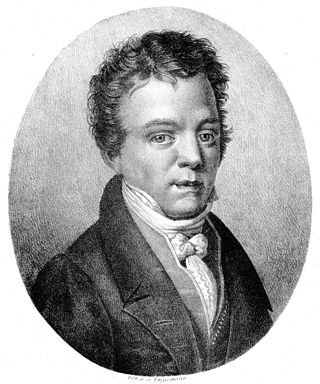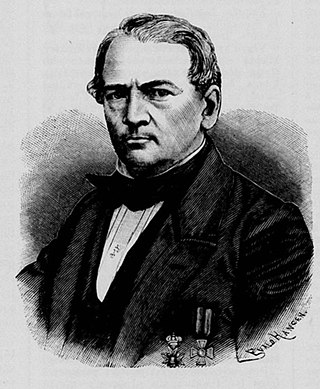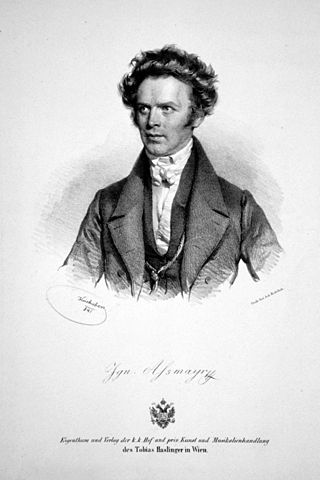
Ferdinand Schubert (born 18 October 1794 in Vienna; died 26 February 1859) was an Austrian composer and brother of Franz Schubert. He also designed the grave stone for the grave of Ludwig van Beethoven, which is now at Vienna's Central Cemetery. [1]

Ferdinand Schubert (born 18 October 1794 in Vienna; died 26 February 1859) was an Austrian composer and brother of Franz Schubert. He also designed the grave stone for the grave of Ludwig van Beethoven, which is now at Vienna's Central Cemetery. [1]
Ferdinand Lukas Schubert was an Austrian teacher, organist and composer. He is notable for his compositions and for his role in publishing the complete works of his younger brother Franz Schubert. He received training in piano and violin from his father, Franz Theodor Schubert, and his older brother Ignaz, later from Michael Holzer, and finally from the public teacher of the choir of St. Anna, Joseph Drechsler. [2] As a boy, Ferdinand played violin in the Schubert family string quartet, with his brothers Franz and Ignaz on viola and violin and his father on cello. Franz Schubert composed many of his early string quartets for this ensemble.
In 1810, Schubert became organist at the Lichtentaler Parish and was also assistant teacher at an orphanage in Vienna. Four years later, in 1816, he was promoted to full-time teacher at the orphanage. In that year, Schubert married one of his students, Anna. In 1818, Franz Schubert composed the German Requiem D621 for Ferdinand, which Ferdinand would later publish and for which he would take credit as his own composition. [3]
In 1820, Schubert became a teacher and choirmaster in Altlerchenfeld. In 1824, he received an appointment as teacher at the Normal-Hauptschule at St. Anna. After his first wife had died, Ferdinand married his second wife, Therese, in 1832. His two marriages produced a total of 29 children, of whom 12 survived to adulthood. In 1838, he became an honorary professor of organ at the Conservatory. Since he was admired in professional circles for his outstanding work as a school administrator, he received the post of director of the normal primary school at St. Anna in 1851.
Ferdinand kept a considerable part of the musical estate of Franz Schubert. With the exception of certain operas, masses, and symphonies, he sold the bulk of Franz Schubert's compositions to Anton Diabelli after Franz's death in 1828. Diabelli's firm published the catalog over the course of the next 30 years, even after Diabelli's death. [4]
Ferdinand also wrote numerous educational journals and a number of sacred compositions and smaller pieces for school use. Although he worked hard all his life, his family lived in poor economic conditions. As such, his will called for any work published after his death to be for the support of his dependents.

AntonDiabelli was an Austrian music publisher, editor and composer. Best known in his time as a publisher, he is most familiar today as the composer of the waltz on which Ludwig van Beethoven wrote his set of thirty-three Diabelli Variations.

Franz Schmidt, also Ferenc Schmidt was an Austro-Hungarian composer, cellist and pianist.

Johann Georg Albrechtsberger was an Austrian composer, organist, and music theorist, and one of the teachers of Ludwig van Beethoven. He was a friend of Haydn and Mozart.

Franz Peter Schubert was an Austrian composer of the late Classical and early Romantic eras. Despite his short life, Schubert left behind a vast oeuvre, including more than 600 secular vocal works, seven complete symphonies, sacred music, operas, incidental music, and a large body of piano and chamber music. His major works include the art songs "Erlkönig", "Gretchen am Spinnrade", "Ave Maria"; the Trout Quintet, the unfinished Symphony No. 8 in B minor, the "Great" Symphony No. 9 in C major, the String Quartet No. 14 Death and the Maiden, a String Quintet, the two sets of Impromptus for solo piano, the three last piano sonatas, the Fantasia in F minor for piano four hands, the opera Fierrabras, the incidental music to the play Rosamunde, and the song cycles Die schöne Müllerin, Winterreise and Schwanengesang.

Carl Czerny was an Austrian composer, teacher, and pianist of Czech origin whose music spanned the late Classical and early Romantic eras. His vast musical production amounted to over a thousand works and his books of studies for the piano are still widely used in piano teaching. He was one of Ludwig van Beethoven's best-known pupils and would later on be one of the main teachers of Franz Liszt.
This article is about music-related events in 1822.
This article is about music-related events in 1824.
This article is about music-related events in 1827.

Franz Xaver Wolfgang Mozart, also known as Wolfgang Amadeus Mozart, Jr., was the youngest child of six born to Wolfgang Amadeus Mozart and his wife Constanze and the younger of his parents' two surviving children. He was a composer, pianist, conductor, and teacher of the late classical period whose musical style was of an early Romanticism, heavily influenced by his father's mature style. He knew Franz Schubert and Robert Schumann, both of whom held him in high esteem.

Ferdinand Ries was a German composer. Ries was a friend, pupil and secretary of Ludwig van Beethoven. He composed eight symphonies, a violin concerto, nine piano concertos, three operas, and numerous other works, including 26 string quartets. In 1838 he published a collection of reminiscences of his teacher Beethoven, co-written with Beethoven's friend, Franz Wegeler. Ries' symphonies, some chamber works—most of them with piano—his violin concerto and his piano concertos have been recorded, exhibiting a style which, given his connection to Beethoven, lies between the Classical and early Romantic styles.

Jan Václav Hugo Voříšek was a Czech composer, pianist, and organist.

The Hellmesberger Quartet was a string quartet formed in Vienna in 1849. It was founded by Joseph Hellmesberger Sr. and was the first permanent named String Quartet.

Ignaz Lachner was a German composer and conductor.

Johann Peter Pixis was a German pianist and composer, born in Mannheim. He lived in Vienna from 1808 to 1824, then in Paris to 1840, during which time he was among the city's most prominent pianists and composers, although he is almost entirely forgotten nowadays.

Ignaz Assmayer was an Austrian composer of liturgical music. An organist at St. Peter's Abbey in Salzburg, he lived in Vienna from 1815, and was in 1846 the conductor of the Court Orchestra. Assmayer was a friend of Franz Schubert.

Philipp Jakob Riotte was a German composer who lived primarily in Vienna. In the 1820s, his works were among the most-performed at the Theater an der Wien. He was a contemporary of Ludwig van Beethoven. Very few of his works remain in the active repertoire today.
Franz Limmer was an Austrian composer, conductor and musical performer.
Joseph Linke was a cellist and composer who had a distinguished career in Vienna, as a soloist and as a member of the Schuppanzigh Quartet. He took part in the first performances of string quartets and other chamber works of Ludwig van Beethoven and Franz Schubert.
From March 1816 to August 1817, Franz Schubert composed four violin sonatas. All four were published after the composer's death: the first three, D 384, 385 and 408, as Sonatinas in 1836, and the last one, D 574, as Duo in 1851. Schubert composed two more pieces for violin and piano, in October 1826 and December 1827 respectively: a Rondo, D 895, which was published during the composer's lifetime (Op. 70), and a Fantasy, D 934, which was premiered in January 1828, less than a year before the composer's death.
In 1816, Franz Schubert composed his first three violin sonatas, D 384, 385 and 408. They were published after the composer's death as Sonatinas in 1836. These sonatas breathe an intimate atmosphere, requiring relatively little virtuoso bravura from their performers.